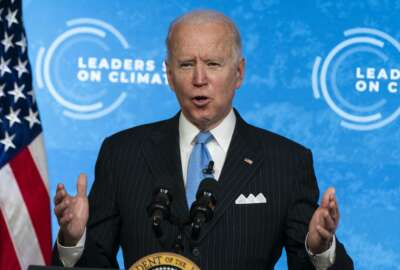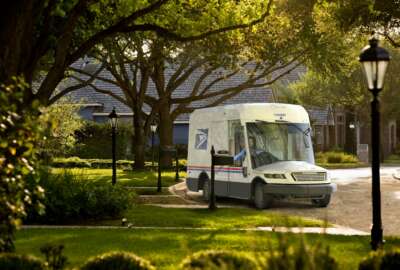

Biden is asking lawmakers to approve $5 billion to support a broader national transition to electric and zero-emission vehicles.
Best listening experience is on Chrome, Firefox or Safari. Subscribe to Federal Drive’s daily audio interviews on Apple Podcasts or PodcastOne.
President Joe Biden set an ambitious goal in the first month of his administration. Through an executive order, he directed agencies to move the entire federal vehicle fleet to electric and zero-emission vehicles.
The Biden administration, to back up that vision, is asking Congress for $600 million for the General Services Administration, the government’s fleet manager, and 18 other agencies to purchase more zero-emission vehicles in fiscal 2022.
Meanwhile, Biden is asking lawmakers to approve $5 billion to support a broader national transition to electric and zero-emission vehicles as part of ongoing negotiations over more than $1 trillion in spending.
The administration is pitching this electric vehicle investment as an opportunity to reduce emissions and improve public health by cutting air pollution. Agencies would also save money in the long term by reducing fuel and maintenance costs on their fleet of more than 650,000 vehicles.
Agencies last year spent $729 million to fuel the federal fleet, and more than $1.3 billion in maintenance and repairs, according to recent GSA data.
Senior leadership within the White House and GSA, however, say agencies have a long way to go before moving the needle on the administration’s goals.
White House National Climate Advisor Gina McCarthy, the former EPA administrator under the Obama administration, said less than 1% of the federal fleet are plug-in electric vehicles, and that agencies bought only 200 electric vehicles last year.
“The opportunities are clear, but first we need to acknowledge that we are starting from a low baseline,” McCarthy said Thursday in closing remarks at GSA’s FedFleet conference.
McCarthy said the White House is finalizing guidance on how agencies should work together to deliver on the president’s “ambitious, but doable goal” to move to zero-emission vehicles. But she said agencies are “way behind” on charging infrastructure, with only 600 charging stations and 2,000 total chargers nationwide.
“We have nowhere to go but up. But let’s not just do better. Let’s show the world what we can do when we work together,” she said.
Biden’s executive order in January directed all federal agencies — including the Postal Service — to move toward “clean and zero-emission vehicles.” A National Climate Task Force, led by the heads of most Cabinet-level agencies, would oversee this transition.
Robin Carnahan, Biden’s pick to run GSA, told the Senate Homeland Security and Governmental Affairs Committee that moving to a zero-emission fleet will require agencies to work closely with industry to address mission needs. Battery life and the prevalence of charging stations, she added, are also common agency concerns.
“There is a limitation now on some of the inventory of vehicles. The missions of some of the agencies have specific vehicle needs, and they’re not always available in the marketplace right now, so signaling to the market what those needs are is going to be important so they can do their planning,” Carnahan said.
Acting GSA Administrator Katy Kale urged agencies to work with the GSA fleet program and its Public Buildings Service as they develop agency-specific plans to transition to electric fleets and install charging stations.
Kale also invited industry partners to work with GSA as it develops blanket purchase agreements to support government electric vehicle purchases, which would, in turn, help make the U.S. a “global leader in electric vehicle production and adoption.”
“We’re doing this by keeping equity at the center of our work. We want everyone to have access to the benefits and the opportunities that come with electrifying the federal fleet. That includes good-paying jobs, improved air quality and better quality of life,” Kale said.
Despite some roadblocks, McCarthy sees some progress. In April, the departments of Energy, Homeland Security, Veterans Affairs, Interior and the Marine Corps collectively purchased more than 150 plug-in vehicles in a single week. The administration, she added, is on track to triple the number of zero-emission vehicles in the federal fleet.
But the Postal Service, which owns and operates more than a third of the total federal fleet, poses another potential hurdle to the administration’s vision for a zero-emission government.
Less than a month after signing the executive order, USPS awarded a 10-year contract for its next-generation delivery vehicles. The agency awarded the contract to Oshkosh Defense, which is prepared to offer a mix of fossil fuel and electric trucks.
USPS, in awarding the contract, passed over the vendor Workhorse, which made the shortlist and offered to manufacture an all-electric fleet.
Postmaster General Louis DeJoy initially told Congress that only 10% of its new fleet would be electric vehicles, but later told lawmakers that figure was “a floor – not a ceiling – based upon our current financial situation.”
DeJoy said USPS won’t place its initial vehicle order until February 2022, and would purchase more vehicles that are electric if Congress gave USPS funding to support the deal.
House lawmakers introduced a bill that would give USPS $6 billion in exchange for a next-generation fleet that’s at least 75% electric or zero-emission. Despite the bill’s introduction, DeJoy told lawmakers that electric delivery vehicles would be “infeasible or impractical” for as many as 12,500 of its routes across the country.
McCarthy, meanwhile, said agencies are beginning to install more electric vehicle chargers, in partnership with local utility companies and other vendors.
Despite the proposed financial support from the White House, McCarthy said delivering on its goals will be a heavy lift for agencies. The project, she added, will require coordination from fleet and building managers, as well as agency financial and acquisition offices, to plan out the infrastructure to charge electric vehicles.
“You’re the ones making the decisions on how to best support your workers and your field offices,” McCarthy told fleet managers. “You are likely sorting through permitting challenges you have never had to experience before, like the first-ever EV charger in your county or your town — and that’s tough. It has to be a bit daunting, and I want you to know just how much we appreciate all of the work that you’re doing.”
Copyright © 2024 Federal News Network. All rights reserved. This website is not intended for users located within the European Economic Area.
Jory Heckman is a reporter at Federal News Network covering U.S. Postal Service, IRS, big data and technology issues.
Follow @jheckmanWFED


